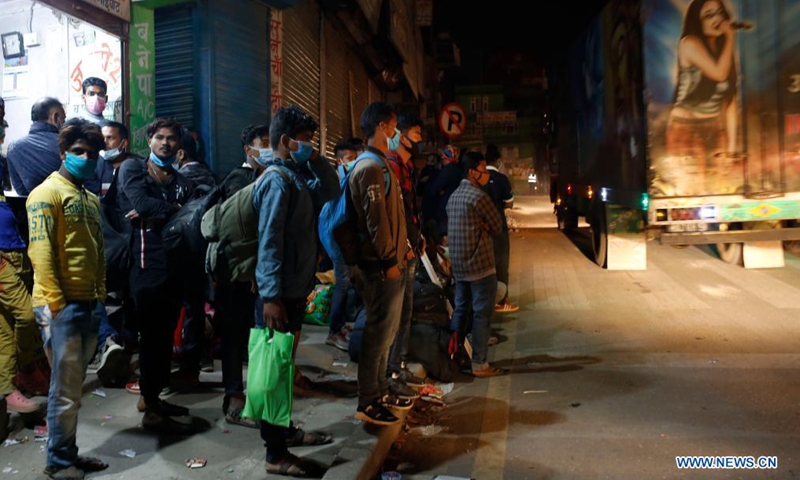New COVID-19 wave may set South, SE Asian economies 20 years back
India’s close neighbors in South and Southeast Asia, home to more than a fourth of the world’s population with high population density and a great number of people living in poverty, have been overwhelmed by India’s deepening coronavirus crisis.
With a much weaker economy and healthcare system, the fierce new COVID-19 wave will deliver a “lethal blow” to the already fragile economy of India’s close neighbors, Chinese observers said, noting it may need 10 to 20 years for neighboring countries to have their economies return to pre-pandemic levels.
India’s COVID-19 crisis has accelerated the virus mutation, and it’s highly likely that quadruple-mutant variants or more highly contagious mutations of novel coronavirus will emerge amid the inevitable third wave in India, and India may not control the epidemic for the next six months, Chinese observers said.
India once again broke the global record on Friday, recording 414,188 newly confirmed cases over 24 hours. The death toll reached 3,915.
Nepal, which shares a long and porous border with India, is suffering from a situation which some people said is as bad as or worse than India’s.
Chinese Foreign Ministry spokesperson Wang Wenbin said at Friday’s media briefing that China has prepared a new batch of medical supplies for Nepal and will send them as soon as possible.
Chen Xiaoshuang, deputy president of the Nepal Overseas Chinese Association who has lived in Nepal since 2016, told the Global Times that he has suspended almost all his work since April 30, the day after the country placed a 2.0 version lockdown for two weeks.
Chen said it’s almost impossible for Nepal to prevent the virus from spreading from India due to frequent personnel exchanges in border areas.
People along the border do not need a visa to cross and an increasing number of Indians have fled to Kathmandu since late April, Chen said. Indian citizens are still allowed to enter Nepal through the southern border points during Nepal’s lockdown, according to the Kathmandu Post.
One of the worst-hit areas outside Kathmandu was Nepalgunj, which is close to the border with India, as thousands of Nepali migrant workers have returned from India, Guardian reported.
Meanwhile, much of Nepal’s necessities rely on imports from India, especially for Nepalis living in the border with India, Chen said.
The country has halted all international flights arriving in Kathmandu until May 14, but it allowed two flights a week from Delhi, according to the Kathmandu Post.
The priority for countries sharing borders with India was to completely shut down the border and prevent the mutant virus from entering those countries, Yang Zhanqiu, deputy director of the pathogen biology department at Wuhan University, told the Global Times.
India has reported double mutant and triple mutant variants of coronavirus since the end of April and many experts believe that the new variants have contributed to the deteriorating situation in India. However, the mutations will not stop there, Yang said.
“It’s very likely that the virus may develop quadruple or more mutations in the third wave of COVID-19 in India that are more transmissible and immune-evasive, making the current vaccines less and less effective,” Yang said.
The accumulated mutations may lead to virus re-assortment and eventually a new coronavirus that is different from the current novel coronavirus, although it may take years, Yang said.
Unfortunately, border control was a common challenge for many other neighbors of India.
In Myanmar, concerns are growing over a third wave of COVID-19 amid months of political upheaval.
Myanmar has shut down all airports and suspended flights since February, but its land border control was not strict, as some Myanmar people could still cross the border to India, although they were escorted back later,
Due to high mountains and dense forests along the border between Myanmar and India, almost no Indians have crossed the border. If Indians came through the land border, the consequence will be hard to imagine given the insufficient medical system in Myanmar.
The spikes in cases in India have also sounded the alarm in Bangladesh which has closed borders. Su Wei, general manager of a Chinese clothing company in Bangladesh, said Bangladeshi students could still return from India by land. About 250 Bangladeshis returned from India on April 30 through a land port, according to local media.
To make matters even worse, those who returned from India were not strictly tested and quarantined.
Chen said that arrivals to Nepal could leave the airport by themselves after presenting their local hotel reservation information, and hotels did not provide disinfectants or body temperature checks. People could either stay at a hotel for self-quarantine or simply walk out and wander on the streets, Chen said.
The streets of Dhaka on Thursday were crowded with people and vehicles, nothing looked like a city under lockdown. The shuttle bus was so crowded that some young people had to cling onto the back door of the bus, the Global Times reporter learned.
Economic abyss
With a far weaker health system and economy, the surge in COVID-19 cases would mean a much harder hit to many of India’s neighbors.
Su said that for many Bangladeshis struggling to make a living, they are more worried about having no money than they are about getting infected.
The lockdown last year has pushed several millions of locals to poverty, Su said. Local workers in Su’s clothing factory insisted on working during the lockdown this year, and most of them earn a monthly salary of 400 yuan ($62) to 500 yuan.
Due to the impact of coronavirus, orders Su’s factory received last year were 60 percent of the year before, and this year the situation might be worse, he said.
According to Su, 2,000 of Bangladesh’s 8,000 clothing factories had closed down in 2020.
Bangladesh is the second-largest apparel producer that heavily relies on cheap labor, and the new wave of infections would hit its industry hard.
For Nepal, Chen said that this year the country’s economy may suffer from a “lethal blow” and will be worse than 2020, as the lockdown 2.0 would mean a double hit to the local tourism industry, which has yet to recover from last year’s COVID-19.
For India’s neighbors that heavily rely on labor, the new wave of coronavirus and various restrictions for labor-intensive factories will greatly affect their economy, Hu Zhiyong, a research fellow at the Institute of International Relations of the Shanghai Academy of Social Sciences, told the Global Times.
Most of these countries depended on India for their economic recovery, and would plunge into the abyss amid India’s deepening crisis, Hu said.
The International Monetary Fund said on Thursday the recent jump in COVID-19 cases in India posed downward risks to the Fund’s forecast for India’s economic output in fiscal years 2021 and 2022, and the development of India would have a spillover effect for the region, Reuters reported.
“It may take 5 to 10 years for South Asian countries’ economies to return to pre-pandemic levels if these countries could control the ongoing wave in two weeks, and if not, their economies may need 20 years to recover,” Hu said.
With 1.89 billion people, South Asia accounts for about a fourth of the world’s population. And South Asia accounted for 35 percent of the world’s 800 million people in poverty.
Many of India’s neighbors have been seeking outside help to control the pandemic and improve their economies since India was busy with its crisis.
According to the Daily Star, the Bangladeshi government is struggling with vaccine supplies as supplies of the Oxford-AstraZeneca vaccine are running out fast.
Bangladeshi Health Minister Zahid Maleque said doses of Sinopharm’s vaccines from China will arrive in Dhaka on May 12, according to the report.
Myanmar received 500,000 doses of Chinese vaccines on Sunday. The donated vaccines, promised by China earlier this year, were handed over at a critical stage of prevention and control against the pandemic, demonstrating the fraternal friendship and spirit of a community with a shared future, said the Chinese embassy in Myanmar.
Aside from vaccine support, China also pledged to help establish a China-South Asia emergency supplies reserve, and a China-South Asia poverty reduction and development cooperation center to exchange experience and good practices in poverty reduction with South Asian countries, and hold a China-South Asia forum on rural e-commerce poverty reduction cooperation as a new platform for poverty reduction in the third quarter of this year, State Councilor and Foreign Minister Wang Yi said on April 27.
Hu said that China has a mature experience in using the central medical reserve in different cities in the COVID-19 battle.
As early as January 2020, China had transferred 14,000 protective suits and 110,000 pairs of gloves from the central medical reserves to Wuhan.
And for emergency supplies reserve in South Asia, China and related countries could pick several places that are safe and conveniently located, and stock necessary medical supplies through purchase or manufacturing, so that the oxygen shortage in India would not spread in the region, Hu said.
People wait for the long route bus to go back to their village prior to lockdown imposed to curb the COVID-19 infections in Kathmandu, Nepal, April 28, 2021.Photo:Xinhua



